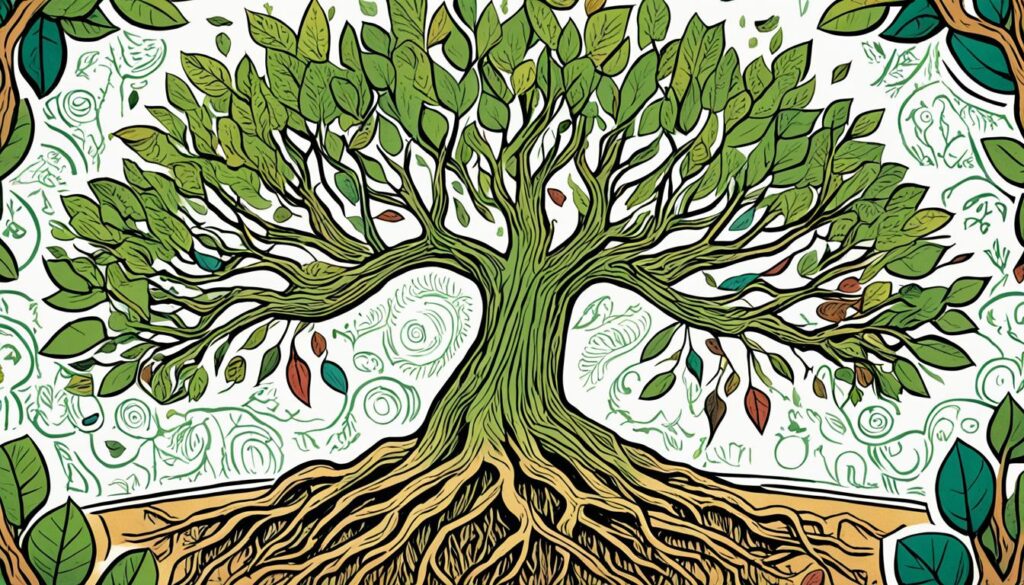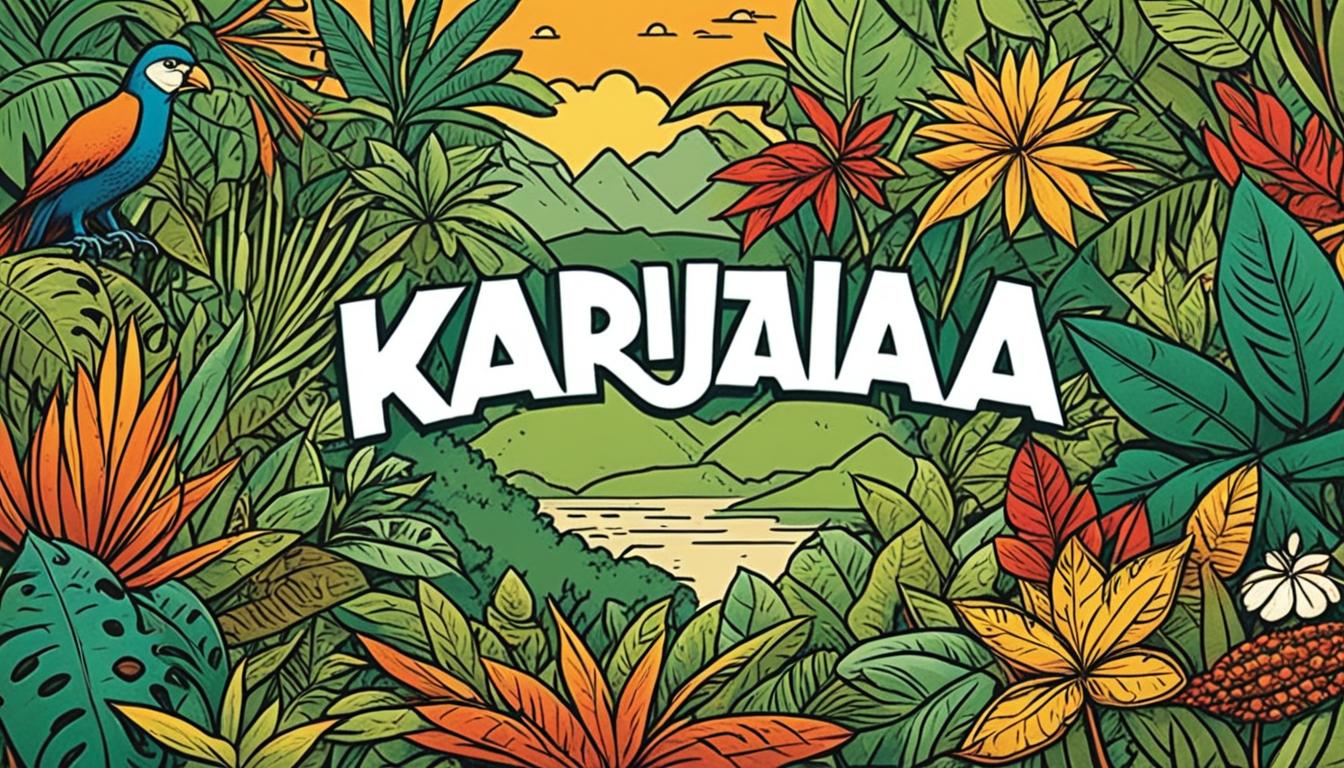Did you know that the Karajá language, an indigenous language spoken by the Karajá people in Brazil, is a linguistic treasure with unique dialects and intricate linguistic features? It is estimated that there are approximately 2,700 speakers of the Karajá language, making it a significant linguistic community striving to preserve their traditional language.
Join us on a fascinating journey as we dive into the phonology, grammar, and lexical differences of the Karajá language. Discover the cultural significance of this language and the tireless efforts made by the Karajá language community to ensure its preservation. Let’s explore the Karajá language together and celebrate its role as a vital part of Brazil’s linguistic and cultural heritage.
Karajá Language: Phonology and Grammar
The Karajá language, also known as Iny rybè, has a unique phonology and grammar that reflects the linguistic richness of the Karajá people. Let’s explore the fascinating aspects of Karajá language phonology, grammar, verb morphology, noun incorporation, and pronouns.
Karajá Language Phonology
The Karajá language features thirteen oral vowels and three nasal vowels. Additionally, vowel harmony and nasalization occur in specific contexts, contributing to the melodic quality of the language. The precise pronunciation and intonation of these vowels play a crucial role in conveying meaning and emotion in Karajá.
Karajá Language Grammar
With a unique consonant inventory, including palatalization and nasal allophones, the Karajá language exhibits a distinct phonetic structure. Verbs in Karajá demonstrate agreement with the subject of the sentence and exhibit impressive inflectional patterns for tense, mood, object, and voice. This rich verb morphology allows for nuanced expression and precise communication.
The Karajá language showcases the complexity and intricacy of indigenous linguistic systems, with an array of verb forms that convey a wealth of information within a single word.
Nouns in Karajá can be incorporated into verbs, enabling dynamic and compact sentence construction. This process of noun incorporation adds depth and flexibility to the language, allowing speakers to express complex ideas concisely.
Karajá Pronouns
In Karajá, there are three personal pronouns: first person, second person, and third person. These pronouns play a vital role in indicating the subject or object of a sentence and contribute to the overall clarity of communication in Karajá. The pronouns in Karajá are tailored to the unique grammatical structure of the language, enhancing its precision and fluidity.
The intricacies of Karajá language phonology and grammar are a testament to the linguistic heritage and cultural identity of the Karajá people. It is through these linguistic features that the Karajá language thrives, connecting generations and preserving the vibrant traditions of the community.
Karajá Language: Dialects and Lexical Differences
The Karajá language, spoken by the Karajá people in Brazil, is characterized by its diverse dialects and lexical variations. Let’s explore the different dialects and the lexical differences within the Karajá language.
1. Karajá Dialects
The Karajá language encompasses four main dialects:
- Northern Karajá
- Southern Karajá
- Javaé
- Xambioá
Each dialect has its own distinct phonological and lexical features.
2. Phonological Differences
For instance, Karajá proper, spoken along the Araguaia River, exhibits unique phonological characteristics. These distinctions contribute to the overall diversity of the Karajá language.
3. Lexical Differences
In addition to phonological variations, there are lexical differences among the dialects. Some lexical items are borrowed from other indigenous communities, while others are loanwords from the Língua Geral Amazônica.

| Dialect | Lexical Differences |
|---|---|
| Northern Karajá | Specific vocabulary related to local flora and fauna. |
| Southern Karajá | Distinct terminology for cultural practices and rituals. |
| Javaé | Vocabulary influenced by neighboring indigenous languages. |
| Xambioá | Loanwords from the Língua Geral Amazônica. |
Despite these differences, speakers of different Karajá dialects can generally understand each other, contributing to the language’s overall cohesion and mutual intelligibility.
“The diverse dialects within the Karajá language showcase the richness and vitality of indigenous languages in Brazil.” – Linguistics Expert
Understanding the variations and lexical differences in the Karajá language is crucial for appreciating the cultural nuances and linguistic heritage of the Karajá people.
Karajá Language: Cultural Significance and Preservation Efforts
The Karajá language holds immense cultural significance for the Karajá people, serving as a vital link to their unique identity and rich cultural heritage. It encapsulates their traditions, values, and worldview, contributing to the preservation of their indigenous knowledge and oral history.
Recognizing the importance of preserving the Karajá language for future generations, various initiatives have been undertaken to document and safeguard this linguistic treasure. Through meticulous documentation projects, linguists and community members work hand in hand to record the grammar, vocabulary, and oral traditions of the Karajá language. These efforts ensure that the language’s intricacies and nuances are meticulously preserved and made accessible for academic research and cultural revitalization.
Moreover, bilingual education programs have been implemented to promote the learning and usage of the Karajá language among younger community members. These programs emphasize the value of indigenous languages, providing a platform for Karajá children and youth to not only learn their mother tongue but also gain a deeper understanding of their cultural heritage. By incorporating the Karajá language into formal education, these programs contribute to its continued vitality and transmission.
Preserving Cultural Traditions
The Karajá language community plays a pivotal role in the preservation and promotion of their language. Their active participation in language conservation efforts, including organizing language workshops, cultural events, and intergenerational language exchange programs, fosters a sense of pride and cultural continuity among Karajá speakers.
“I believe that preserving our Karajá language is preserving our culture, our worldview, and our connection to our ancestors. It gives us a stronger sense of identity and helps us strengthen our community bonds.”
The documentation and revitalization of the Karajá language not only ensure the continuity of cultural traditions but also empower the Karajá people to reclaim their narrative and assert their rightful place in the larger Brazilian society.
Promoting Cultural Resilience
Preserving the Karajá language is not without challenges. The influence of dominant languages, urbanization, and globalization pose threats to the language’s vitality. However, the dedication and resilience of the Karajá language community serve as a beacon of hope.
Through their unwavering commitment, the Karajá people are actively adapting to modern contexts while safeguarding their cultural heritage. By nurturing multilingualism and encouraging intergenerational language transmission, they ensure the Karajá language thrives amidst evolving societal dynamics.
In conclusion, the Karajá language holds deep cultural significance for the Karajá people, serving as a cornerstone of their identity and heritage. The preservation efforts through documentation projects and bilingual education programs, combined with the active involvement of the Karajá language community, help safeguard this invaluable linguistic treasure. By cherishing and revitalizing their language, the Karajá people ensure the continuity of their cultural traditions and foster resilience in the face of external influences.
Conclusion
The Karajá language serves as a vibrant thread in the rich cultural tapestry of Brazil, embodying the enduring legacy of indigenous wisdom. Its unique phonology, grammar, and dialects are a testament to the diversity and linguistic richness of the Karajá people.
Efforts to preserve and study the Karajá language are of paramount importance in ensuring its continued vitality and transmission to future generations. The dedication displayed by the Karajá language community in preserving their mother tongue is a powerful example of cultural resilience and identity.
Looking to the future, it is crucial that we support these preservation efforts and celebrate the Karajá language as an integral part of Brazil’s linguistic and cultural heritage. By doing so, we can honor the traditions and wisdom of the Karajá people, fostering an environment where their language thrives and continues to be cherished for generations to come.
FAQ
What is the Karajá language?
The Karajá language, also known as Iny rybè, is the indigenous language spoken by the Karajá people in Brazil.
How many dialects does the Karajá language have?
The Karajá language has four dialects: Northern Karajá, Southern Karajá, Javaé, and Xambioá.
What are the linguistic features of the Karajá language?
The Karajá language is verb-final and has complex verbal morphology. It has distinct male and female forms of speech and features vowel harmony and vowel nasalization in certain contexts. The language also has a unique consonant inventory with palatalization and nasal allophones.
How many speakers does the Karajá language have?
The Karajá language is currently spoken by approximately 2,700 speakers.
What efforts are being made to preserve the Karajá language?
There are documentation projects and bilingual education programs aimed at preserving the Karajá language. These initiatives ensure that the younger generations continue to learn and speak the language, preserving its cultural traditions.
What are the different dialects of the Karajá language?
The Karajá language has four dialects: Northern Karajá, Southern Karajá, Javaé, and Xambioá. Each dialect has its own phonological and lexical differences, but speakers of different dialects can generally understand each other.
What is the cultural significance of the Karajá language?
The Karajá language represents the unique identity and cultural heritage of the Karajá people. It is of great importance to their cultural traditions.
How is the Karajá language being preserved?
The Karajá language is being preserved through documentation projects and bilingual education programs that aim to ensure its continued use and transmission to future generations.
What is the role of the Karajá language community in preserving the language?
The Karajá language community plays a crucial role in promoting and preserving the language, allowing it to thrive in the face of external influences.
Why is it important to study the Karajá language?
Studying the Karajá language is important for understanding the linguistic richness of the Karajá people and ensuring the language’s continued vitality and transmission to future generations.
What is the future of the Karajá language?
The future of the Karajá language depends on the continued support for preservation efforts and recognition of its significance as a part of Brazil’s linguistic and cultural heritage.
